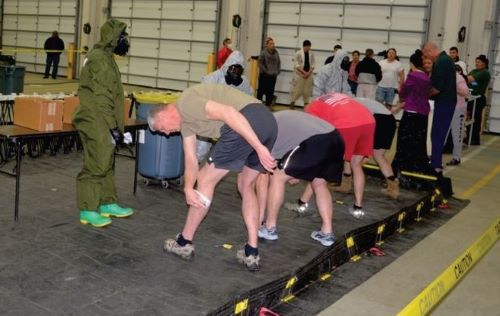Nonwoven Wipe Technology Demonstrates Value in the Arctic
The cotton-based FiberTect decontamination wipe has proven its value in the Arctic Circle.
Fredericksburg, VA-based First Line Technology successfully demonstrated the efficiency of cold weather decontamination during a training event at Samuel Simmonds Memorial Hospital in Utqiagvk, AK, using the FiberTect nonwoven dry decontamination wipe for patient and responder decontamination.
The hospital is in the northernmost part of the United States, 350 miles above the Arctic Circle and bordering the Arctic Ocean. The average temperature in this region is 17oF.
Demonstration of FiberTect decontamination at the Anchorage Fire Training Center. (Source: CRREL, U.S. Army)
Samuel Simmonds Memorial Hospital is the only hospital providing healthcare services in the North Slope Borough of Alaska. This area is an oil drilling region, as well being prone to fentanyl and other opioid addiction issues. First receiver teams must be adequately equipped with decontamination technology that works in severe cold weather conditions.
The FiberTect dry decontamination wipe was invented in the Nonwovens & Advanced Materials Laboratory at Texas Tech University and is a model for lab-to-reality translational research. The technology is part of the “Hybrid Decontamination” approach commercialized by First Line Technology.
Normal liquid-based decontamination technologies are not efficient in extreme cold weather environments below 35oF. In these areas, patient and surface decontamination with soap and water is not feasible. During the training exercise in Alaska, the maximum temperature with high winds was only 14oF.
“FiberTect is allowing first receivers and first responders to perform effective decontamination in austere temperatures where other decontamination approaches may not be viable,” states Corey Collings, Director at First Line Technology. “Due to its patented structure, the FiberTect nonwoven wipe can effectively remove fentanyl and radiological particles, as well.”
Dry decontamination using the FiberTect technology works well on many toxic chemicals that have high vapor pressure. First Line Technology has perfected the protocol where contaminants like fentanyls are removed from the skin and other surfaces. These toxic substances can further be degraded using Dahlgren Decon.
Collings notes that the hybrid decontamination technology involves dry FiberTect with Dahlgren Decon or Dahlgren Part A soap, depending on the nature of the contamination.
In addition to decontamination solutions, the FiberTect nonwoven technology continues to find broader applications on its own in the United States and overseas.











